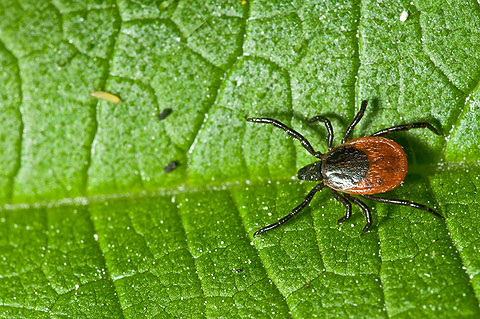Ticks are small insects that feed on blood – both from diseased and healthy animals, and under certain circumstances – and people. Thus, each tick can transmit disease organisms any subsequent bites an animal or a person for a long time. In some cases, the microorganisms are passed on to subsequent generations ticks, which in turn continue the spread of the disease in both animals and humans.
These diseases are characterized by a spring – summer seasonal peak of incidence during the months of June and July. During these months, everyone should be with caution when in nature, properly dressed and always examine your body then a tick bite.
It is necessary to avoid places where there may be ticks / bushes, abundant vegetation / wear suitable clothing and footwear protecting against ticks regularly deworming livestock and mow lawns.
Places where children play should be treated with chemical agents that kill ticks.

Ticks can by bloodsucking cause many dangerous diseases such as Marseilles fever, Lyme disease, Crimean-Congo hemorrhagic fever, tularemia and Q fever.
When a tick bite is necessary to immediately seek medical attention and tick be removed because all of these diseases are very dangerous and can lead to unpleasant consequences, including death. It has been shown that the longer the tick remains fixed on human skin, the greater the risk of infection. Removal should be done very gently, taking care not to tear part of it remain under the skin bites man, where can now more blood to enter deeper and treatment has become difficult and the risk of infection increases repeatedly.
What should not be done in a tick bite?
There practice left over from the past and transmitted by word of mouth that a tick bite should be greased place with some fat to wait a few hours and then grab the tick and turn it counterclockwise to remove. Do not do this alone never home because it is wrong. Waiting for these few hours after the bite, and may well be more – there is no way to accurately know how long it is there is further enabling the infection. In no event should not wait if we find the tick and try to take out themselves very risky.
Another mistake that is made on the tick bite is to cauterize the insect itself while it is fixed on the human body. This is even more wrong, because in firing tick is stressed and spit and thus increase the chances of transmitting the eventual infection.
Every year hundreds of people are infected by Lyme hurt as a result of a tick bite.
What is Lyme disease?
It is the razprastranenoto disease caused by a tick bite. Causes are bacteria called borelii. Ticks appeared carriers of these borelii.
Lyme disease is manifested by various combinations of symptoms resulting from damage to the skin, joints, nervous system, heart and even more rarely – muscles, eyes, liver.
Infection is characterized by a chronic relapsing-flow, whereby one can distinguish three main stages:
First stage – early localized Lyme borreliosis. The events are mainly from the skin – called erythema migrans. Erythema red, pink or slightly pigmented oval plaque that forms in the place where he was close-fitting tick. It grows 1 to 3 weeks after the bite and go for about a month. It is possible, however, to retain and to 1 year.
Second stage – early disseminated Lyme borreliosis. Skin appear red variety. It is possible damage to the nervous system that develops 2-3 months after the bite and manifests as radikulonevrit with radikulitna pain, facial nerve paresis, muscle weakness, headache, fatigue, meningitis. May be affected joints and heart. These symptoms usually disappear after 6 to 12 months.
Third stage – late chronic Lyme borreliosis. It develops most frequently in the absence of treatment. It is characterized by delayed cutaneous manifestations of the type of dermatitis, arthritis and chronic effect on the nervous system.
When Lyme disease prognosis largely depends on prompt diagnosis and early initiation of antibiotic treatment, allowing the disease to stop its development and does not get to a chronic process. It should be borne in mind that the healing process is long and continuous, sometimes for years.
Extraction of a tick – how to do it?
Yet if it happens to you tick bite and can not quickly reach a doctor’s office, not bad to know how to pull a tick:
The right way when you pull a tick to happen with tweezers or by hand, but always with gloves. Try to grasp the tick as possible close to his head, where was staring into the skin. Then you make sure that you hold it without turning, carefully pull it out. Look carefully then the place to be sure that you have removed whole. In deep close-fitting tick or when extractions tick in the skin are the rest of it is best – to contact the surgeon.
What is good to know when extracting a tick!
- Mandatory after removing the tick area should be disinfected with iodine.
- The removed tick is placed in a vial and sway to study in the laboratory of HEI (HEI). If not possible, the tick must be incinerated or placed in alcohol.
- Do not crush the tick because it can spray the contents of the tick fall into your eyes and get sick without even’ve been bitten.
- Always tick bite one must at least 30 days to be alert and in the smallest deviations or symptoms to seek medical attention. Especially if you notice suspicious site redness or fever.
 Happy at Home Family Problems & Solutions | Home & Health Tips
Happy at Home Family Problems & Solutions | Home & Health Tips
